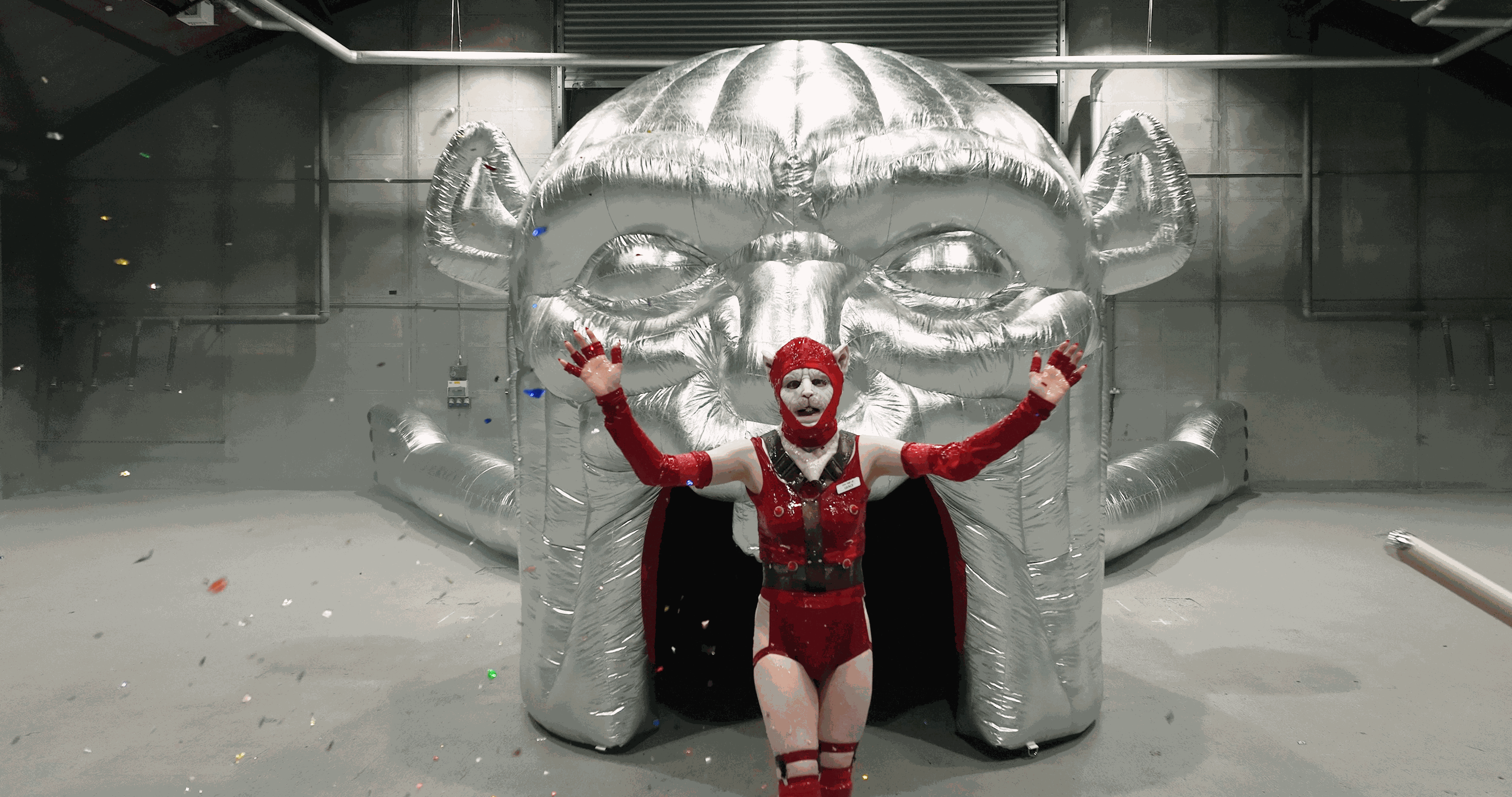01 March 2023 What happens if you take a troupe of rodent-humans, pump them with liquid stimulants and make them compete in a non-stop dance marathon that pushes the limits of physical and mental endurance? Enter Jenkin van Zyl's Surrender: a hallucinogenic film installation that consumes the viewer's nervous system with relentless abandon.
London-based van Zyl is known for a body of work that pays homage to the thrilling, mysterious glamour of monsters and roving outcasts. In films such as Escape from Fort Bravo, 2016, and Looners, 2019, the artist creates witchy fantasies channelling everything from spaghetti westerns to club kid aesthetics through the manipulation of rubber, silicone and horns.
The exhibition takes over the gallery's entire ground floor. A giant inflatable rat's head forms the entrance, bunting strung overhead like a demented children's party. Inside, a series of intercoms are displayed under seedy red lighting, the buzzers labelled: 'Absolute Pleasure', 'Public/Private Parts', 'Former Celebrity'. Dazed and curious, we find ourselves spat out into the pay-per-hour anonymity of the P.E.E.P. Hotel. Modelled on a Japanese love hotel, four beds face a single-channel screen, inviting us to become voyeurs.
The 50-minute film begins with the main protagonist, Grace (played by Alex Margo Arden), walking with a suitcase and heart-shaped balloon. With her prosthetic rodent snout, black vinyl gloves and trench coat, it's like a scene from a Matthew Barney-directed reboot of Madonna's 'Justify My Love'. Gnomic messages are scribbled onscreen: 'The end is often the beginning.' Grace takes a party limo to a grungy working men's club. We see maids cleaning up the mess - smeared cake, a discarded mattress - presumably from the previous event. The camera cuts to footage of fireworks, before plunging endoscope-like through a person's insides: a sci-fi voyage into inner space. So much about this film, with its tight focus on sensation, mimics what it's like to live inside a feeling: anticipation, euphoria, boredom and exhaustion. The brain cosplays a body.

Jenkin van Zyl, Surrender (still), 2023, 4K single channel film, 48:46 min. Edition of 5 plus 2 artist's proofs.
In the following scenes, couples dressed in rat outfits begin meeting at the hotel. The viewer, occupying an identical room in the gallery space, has the disorienting sense of being scripted into the plot itself. The rat couples transform into matching red skin-tight club gear and jockstraps while downing cans of a 'Limitless Growth' drink (replicas of which are stacked and spot-lit in a mirrored room next door). The idea of the body as something that can be tweaked and 'gamified' - the 'rat race' indeed - underpins the narrative. Hedonism becomes both a bid for transcendence and a means of survival under late-capitalism, wherein productivity is rebranded as play.
Inside the ballroom, the four pairs of rats waltz in competitive duration. A metronome keeps time with the performers' 'tra-la-la of pumping blood'. A message flashes: 'We congregated because we all craved the same thing: escape.' Queer culture has long celebrated the dancefloor as a kind of liberation: a utopia that exists in the space of a night. The images blur into hyper-speed, as if mimicking a chemical rush. A joke-shop gun pops: 'BANG!'
Throughout the film, a constant, low-level sense of menace bubbles. A surreal weather report announces alligators in the hotel's sewer system. There's a deadlock between the 'floor referees' who keep the competitors moving along and the 'P.A.I.N Nurses', dressed as alien brides, who advise rest and give smothering hugs. Pleasure edges towards self-obliteration: 'Our bodies were less solid containers than networks, blurs.' The phrase 'Surrender Grace' is ominously burned into the hotel ceiling with matches.
How group identity is formed (and deformed) is one of Surrender's central themes. We see the rats - reviled outsiders shadowing human society - engage in what might be considered communal activities such as 'marathon hand-holding' and wilderness survival. We watch them assemble the giant red inflatable innards of the entrance but, in turn, become 'just tangled limbs' brutalised by blasts of techno. (These scenes bear the influence of Gaspar Noe's 2018 film Climax: a dance-off descending into a series of overlap- ping panic attacks.)
The rituals of wider society are inverted. There is even a 'mass jilting' - an anti-wedding with bells - before the dancers gorge on one last meal together, taking fistfuls of trophy-shaped cake. A final SOS pleads: 'Knowing it was nearly the end, I whispered to you: don't use up your lifeline before we meet again.' The rats, slumped and unconscious, are sealed into cryogenic suits by the nurses. The empty dancefloor now contains only a bed. Grace burrows inside, drool and feathers flying.
Tunnelling back, the main protagonist exits through the giant rat's head. Two bouncers fire confetti cannons. Ouroboros-like, we've returned to the start. What does it mean to win? Is there 'no happier place than a loser's' after all? Grace receives an engraved gold plaque for 'sincere and concerted' effort. Then - finally, fittingly - collapses.


